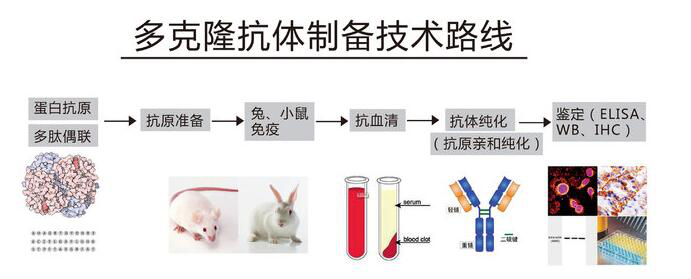
|

| 产地 | 进口、国产 |
| 品牌 | 上海莼试 |
| 保存条件 | Store at -20 °C |
| 货号 | CS11398 |
| 应用范围 | WB=1:100-500 ELISA=1:500-1000 IHC-P=1:100-500 IHC-F=1:100-500 ICC=1:100-500 IF=1:100-500 |
| CAS编号 | |
| 抗体名 | Anti-SLC38A2/SNAT2 |
| 克隆性 | |
| 靶点 | 详见说明书 |
| 适应物种 | 详见说明书 |
| 形态 | 详见说明书 |
| 宿主 | 详见说明书 |
| 亚型 | IgG |
| 标识物 | 详见说明书 |
| 浓度 | 1mg/1ml% |
| 免疫原 | KLH conjugated synthetic peptide derived from human SLC38A2/SNAT2 |
全、新、优、品、好四大特点:
氨基酸转运蛋白2抗体规格 全:公司提供上万种产品,涵盖了生物试剂,elisa试剂盒,标准品,培养基,原装耗材,抗体、培养基、ATCC细胞等,基本上各种科研所需产品在我司都能找到。
新:产品更新速度较快,基本上每周都有新产品出现。
优:产品质量好,投诉比较少。
好:我公司具有优质的技术团队,产品一旦售出,实验过程中遇到困难可提供在线技术咨询。使您使用产品时没有任何的后顾之忧。
氨基酸转运蛋白2抗体规格 英文名称 Anti-SLC38A2/SNAT2
中文名称 氨基酸转运蛋白2抗体规格
别 名 Amino acid transporter 2; Amino acid transporter A2; ATA2; KIAA1382; PRO1068; Protein 40-9-1; S38A2_HUMAN; SAT2; Slc38a2; SNAT2; Sodium-coupled neutral amino acid transporter 2; Solute carrier family 38 member 2; System A amino acid transporter; System A amino acid transporter 2; System A transporter 1; System N amino acid transporter 2.
产品属性:
浓 度 1mg/1ml
规 格 0.2ml/200μg
抗体来源 Rabbit
克隆类型 polyclonal
交叉反应 Human, Mouse, Rat, Dog, Pig, Cow, Horse, Sheep
产品类型 一抗
研究领域 神经生物学 通道蛋白 细胞膜受体 转运蛋白
蛋白分子量 predicted molecular weight: 56kDa
性 状 Lyophilized or Liquid
免 疫 原 KLH conjugated synthetic peptide derived from human SLC38A2/SNAT2
亚 型 IgG
纯化方法 affinity purified by Protein A
储 存 液 Preservative: 15mM Sodium Azide, Constituents: 1% BSA, 0.01M PBS, pH 7.4
氨基酸转运蛋白2抗体规格 产品应用 WB=1:100-500 ELISA=1:500-1000 IHC-P=1:100-500 IHC-F=1:100-500 ICC=1:100-500 IF=1:100-500
(石蜡切片需做抗原修复)
not yet tested in other applications.
optimal dilutions/concentrations should be determined by the end user.
保存条件 Store at -20 °C for one year. Avoid repeated freeze/thaw cycles. The lyophilized antibody is stable at room temperature for at least one month and for greater than a year when kept at -20°C. When reconstituted in sterile pH 7.4 0.01M PBS or diluent of antibody the antibody is stable for at least two weeks at 2-4 °C.
Important Note This product as supplied is intended for research use only, not for use in human, therapeutic or diagnostic applications.
产品介绍 The sodium-coupled neutral amino acid transporters (SNAT) of the SLC38 gene family include System A subtypes SNAT1, SNAT2 and SNAT4 and System N subtypes SNAT3 and SNAT5. The SLC38 transporters are essential for the uptake of nutrients, energy production, metabolism, detoxification, and the cycling of neurotransmitters. SNAT2, also designated ATA2, PRO1068 and SAT2 is encoded by the human gene SLC38A2. The functional role of SNAT2 in the nervous system is unclear. Protein expression is notably enriched in the spinal cord and brain stem nuclei of the auditory system. System A transport proteins are also present in placental tissue. These SNAT proteins may play a significant role in fetal development and inhibition of the transport system has been associated with fetal growth retardation.
Function : Functions as a sodium-dependent amino acid transporter. Mediates the saturable, pH-sensitive and electrogenic cotransport of neutral amino acids and sodium ions with a stoichiometry of 1:1. May function in the transport of amino acids at the blood-brain barrier and in the supply of maternal nutrients to the fetus through the placenta.
Subcellular Location : Cell membrane. Insulin promotes recruitment to the plasma membrane from a pool localized in the trans-Golgi network or endosomes (By similarity). Enriched in the somatodendritic compartment of neurons, it is also detected at the axonal shaft but excluded from the nerve terminal.
Tissue Specificity : Ubiquitously expressed. Widely expressed in the central nervous system with higher concentrations in caudal regions. Expressed by glutamatergic and GABAergic neurons together with astrocytes and other non-neuronal cells in the cerebral cortex (at protein level).
Post-translational modifications : Polyubiquitination by NEDD4L regulates the degradation and the activity of SLC38A2.
Similarity : Belongs to the amino acid/polyamine transporter 2 family.
Database links : UniProtKB/Swiss-Prot: Q96QD8.2
实验流程:

正在热销的相关产品:
Anti-phospho-STAT1 (Ser727) /FITC 荧光素标记磷酸化信号转导与转录激活因子1抗体IgGMulti-class antibodies规格: 0.2ml
MMP-14(Matrix metalloproteinase-14) 金属基质蛋白酶-14Multi-class antibodies规格: 0.5mg
P-糖蛋白 Anti-P-GP 0.1ml
SLAMF6 英文名称: SLAMF6抗体 0.2ml
Egr1 英文名称: 早期生长应答蛋白1抗体 0.1ml
Rhesus antibody Rh phospho-Myosin light chain(Ser20) 磷酸化肌球蛋白轻链抗体 规格 0.1ml
MMP-14(Matrix metalloproteinase-14) 金属基质蛋白酶-14Multi-class antibodies规格: 0.5mg
KiSS-1R/GPR54/GPCR54(KiSS-1 receptor/G-Protein Coupled Receptor 54) G蛋白偶联受体54抗原Multi-class antibodies规格: 0.5mg
PRDX6 Peroxiredoxin 6 / PRDX6 鼠单抗 (FITC) Human
Rhesus antibody Rh Phospho-CRMP2 (Thr514) 磷酸化二氢嘧啶酶样2抗体 规格 0.1ml
考马斯亮蓝G-250溶液 100ml/500ml 自产
ZFP219 英文名称: 锌指蛋白219抗体 0.2ml
DLC1 英文名称: 胞浆动力蛋白轻链1抗体 0.2ml
PRDX6 Peroxiredoxin 6 / PRDX6 鼠单抗 (FITC) Human
pre-X protein(CT)[Hepatitis B virus C-Terminus] 乙毒pre-X蛋白抗原(C端)Multi-class antibodies规格: 0.5mg
Anti-B7-H1/CD274 程序性死亡配体1抗体Multi-class antibodies规格: 0.1ml
Rhesus antibody Rh phospho-Afadin(Ser1718) 磷酸化丝状肌动蛋白结合蛋白抗体 规格 0.1ml
MGMT 浓缩液 0.1ml 进口分装
Upstream Binding Protein 1 英文名称: 上游结合蛋白1抗体 0.1ml
CCK39 英文名称: 胆囊收缩素39抗体 0.1ml
Anti-B7-H1/CD274 程序性死亡配体1抗体Multi-class antibodies规格: 0.1ml
LEP Protein Human 重组人 Leptin 蛋白
小鼠平滑肌细胞完全培养基 100mL
CD3E Others Cynomolgus 食蟹猴 CD3e / CD3 epsilon 人细胞裂解液 (阳性对照)
Y1小鼠肾上腺皮质瘤细胞 Y1 mouse adrenocortical tumor cells RPMI-1640(GIBCO)+10%FBS
CL-0071CT26.WT(小鼠细胞)5×106cells/瓶×2
SF17(人细胞) 5×106cells/瓶×2 RT4(细胞)
CM-M064小鼠上皮细胞完全培养基100mL
SPARCL1 Others Mouse 小鼠 SPARCL1 / SPARC-like 1 人细胞裂解液 (阳性对照)
扁桃体上皮细胞培养基TEpiCM-prf
PC-12细胞,大鼠肾上腺嗜铬细胞瘤 人细胞,KC细胞 组织源性原代细胞Many types of cells包装:5 × 105次方(1ml)/1ml
猪肾细胞;PK(15)
PLAU Others Human 人 uPA / PLAU 人细胞裂解液 (阳性对照)
氨基酸转运蛋白2抗体规格 LEP Protein Human 重组人 Leptin 蛋白
小鼠平滑肌细胞完全培养基 100mL
CD3E Others Cynomolgus 食蟹猴 CD3e / CD3 epsilon 人细胞裂解液 (阳性对照)
Y1小鼠肾上腺皮质瘤细胞 Y1 mouse adrenocortical tumor cells RPMI-1640(GIBCO)+10%FBS
CL-0071CT26.WT(小鼠细胞)5×106cells/瓶×2
SF17(人细胞) 5×106cells/瓶×2 RT4(细胞)
技术外包服务:
★氨基酸转运蛋白2抗体规格 分子生物学:质粒抽提、PCR、Q-PCR、RT-PCR、分子生物学:基因合成、引物合成、基因测序、载体构建等
★蛋白工程:原核、哺乳动物蛋白表达系统等
★病毒包装:腺病毒、慢病毒等
★抗体工程:磁珠分选、病理染色、WB、ELISA、IP、IF、IHC、FACS、Confocal等等
★细胞工程:细胞表型分析(凋亡、增殖、周期、迁移、侵袭、修复、克隆形成)、细胞培养、细胞膜制备、稳定细胞株构建、细胞RNAi技术等等。